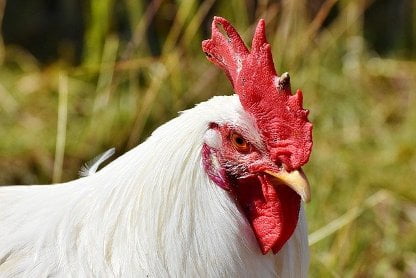H10N3 Bird Flu UPSC | Symptoms In Humans | UPSC Current Affairs – A 41-year-old man in China’s eastern Jiangsu Province is the first known human to be infected with a strain of bird flu known as H10N3, China’s National Health Commission — a development that experts said merited close monitoring because of an underlying continued risk of pandemic flus. China has reported the first case of human infection with the H10N3 strain of bird flu in Jiangsu province.

H10N3 Bird Flu UPSC | Symptoms In Humans | UPSC Current Affairs
Influenza viruses are classified into subtypes based on two surface proteins, Hemagglutinin (HA) and Neuraminidase (NA). For example, a virus that has an HA 7 protein and NA 9 protein is designated as subtype H7N9.
Key Points About H10N3 Bird Flu
- H10N3 is a subtype of the Influenza A virus which is commonly known as the bird flu virus.
- These illnesses are common in wild aquatic birds worldwide and can infect domestic poultry and other bird and animal species.
- It is a low pathogenic, or relatively less severe, strain of the virus in poultry.
- the risk of it spreading on a large scale is very low.
- Among animals it can spread through respiratory droplets.
- There has not been any case of human infection of H10N3reported in the world before.
- Many different strains of avian influenza are present in China and some sporadically infect people, usually those working with poultry.
- There have been no significant numbers of human infections with bird flu since the H7N9 strain killed around 300 people during 2016-2017.
- Infected birds shed avian flu in their saliva, mucus, and poop, and humans can get infected when enough of the virus gets in the eyes, nose, or mouth, or is inhaled from infected droplets or dust.
World Organization for Animal Health
|
Black Fungus UPSC | What is Mucormycosis | Symptoms | Causes |
How to prevent the spread of H10N3 among people’?
- People should avoid contact with sick or dead poultry and avoid direct contact with live birds as much as possible.
- People must pay attention to food hygiene at the moment.
- People should wear masks and improve self-protection awareness, while constantly monitoring fever and respiratory symptoms.
White Fungus UPSC | Causes | Symptoms | Spread | Treatment
Different strains of bird flu: H10N3 Bird Flu UPSC
| H7N9 virus |
|
| H5N8 |
|
| H5N6 |
|
What Is Bird Flu ?
- Avian influenza, sometimes called bird flu or avian flu, is a disease of birds, usually carried by wild ducks and other waterbirds.
- Sometimes, this disease can also spread from wild birds into domestic poultry.
- Although avian influenza and human influenza are both caused by influenza viruses, each virus generally affects either birds or people, not both.
- However, some humans have been infected with avian influenza viruses following contact with infected birds.
- It is a highly contagious viral disease affecting several species of food-producing birds (chickens, turkeys, quails, guinea fowl, etc.) as well as pet birds and wild birds.
- Occasionally mammals, including humans, may contract avian influenza.
Types of Influenza Viruses: H10N3 Bird Flu UPSC
Influenza viruses are grouped into three types; A, B, and C.. Full Details of The Viruses Are Mentioned Below.
- Only type A is known to infect animals and is zoonotic, meaning it can also infect humans.
- Avian influenza virus subtypes include A(H5N1), A(H7N9), A(H9N2) and A(H10N3).
- Type B and C mostly infect humans and typically cause mild disease.
What are the symptoms of bird flu?
- The symptoms may include fever (often high fever, > 38°C) and malaise, cough, sore throat, and muscle aches.
- Other early symptoms may include abdominal pain, chest pain, and diarrhea.
- The infection may progress quickly to severe respiratory illness (for example, difficulty breathing or shortness of breath, pneumonia, Acute Respiratory Distress Syndrome) and neurologic changes (altered mental status or seizures).
Impact of Bird flu Virus in Poultry Industry
- Avian Influenza outbreaks can lead to devastating consequences for the poultry industry.
- Farmers might experience a high level of mortality in their flocks, with rates often around 50%.
- For Many Months People Avoid Buying Chicken.
- Some Time Its Impact Is Longterm
What can I do to protect myself and my family from avian influenza viruses?
There are general precautions that can be taken to reduce the chance of getting sick from any disease carried by animals:
- Washing hands after contact with animals;
- Avoiding contact with animals that appear to be sick, including birds;
- Thoroughly cooking eggs and meat prior to eating, and washing all utensils and preparation areas thoroughly with soap and hot water;
- Washing hands frequently when preparing food;
- Owners of domestic livestock, including poultry and waterfowl, should contact their local veterinarian if any of their animals appear sick;
- Hunters should hunt and process only healthy-appearing animals, wear gloves when handling any animal, clean and disinfect any equipment used for cleaning game, and cook all game thoroughly.
If an avian influenza virus is found in the U.S. that is thought to be a substantial risk to human health, any precautions necessary to prevent human infection will be publicized by the appropriate authorities.
Source – The Hindu / Indian Express / Google News







